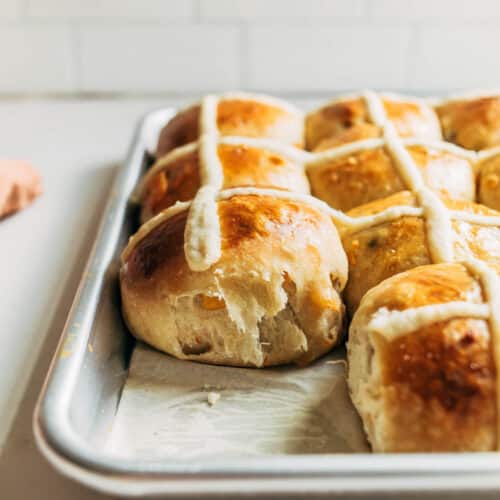With just 8 ingredients, which you probably already have on hand, these sourdough cinnamon rolls are easy enough for beginners and oh-so-good. Fluffy, just sweet enough, and with two methods to suit your schedule.
We've been testing this recipe for a long time, over a year, and it's exactly what we want in a cinnamon bun! Soft without being hard to work with (refrigerate before rolling!) and with just the right ratio of filling to dough. Like our sourdough dinner rolls, it's an enriched dough, but it can actually be easier to work with than a basic sourdough.
This is seriously cozy food, and just the right thing to curl up with on a chilly day, especially topped with cream cheese frosting. If you've been thinking about upping your sourdough game, give them a try!
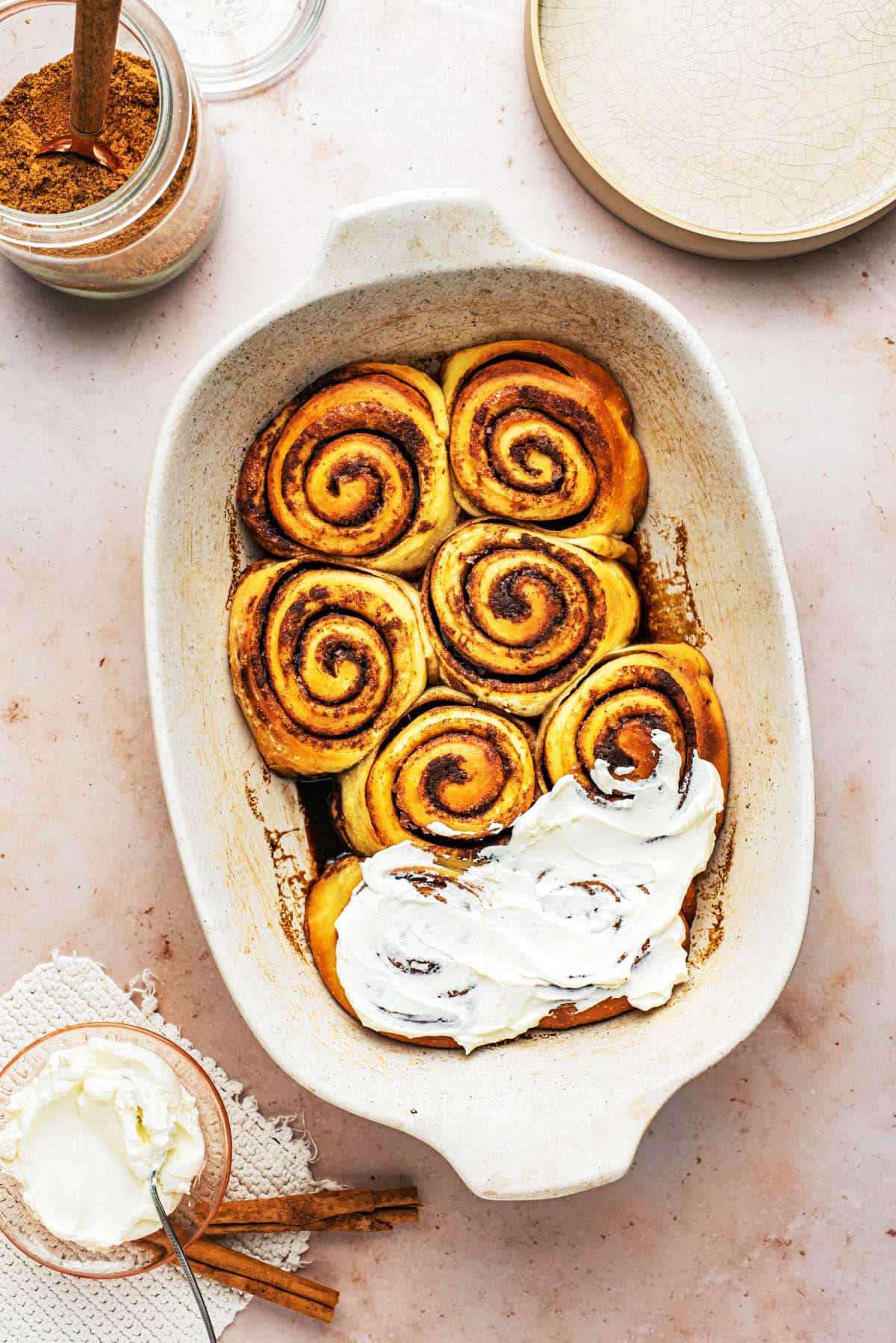
Jump to:
Ingredients
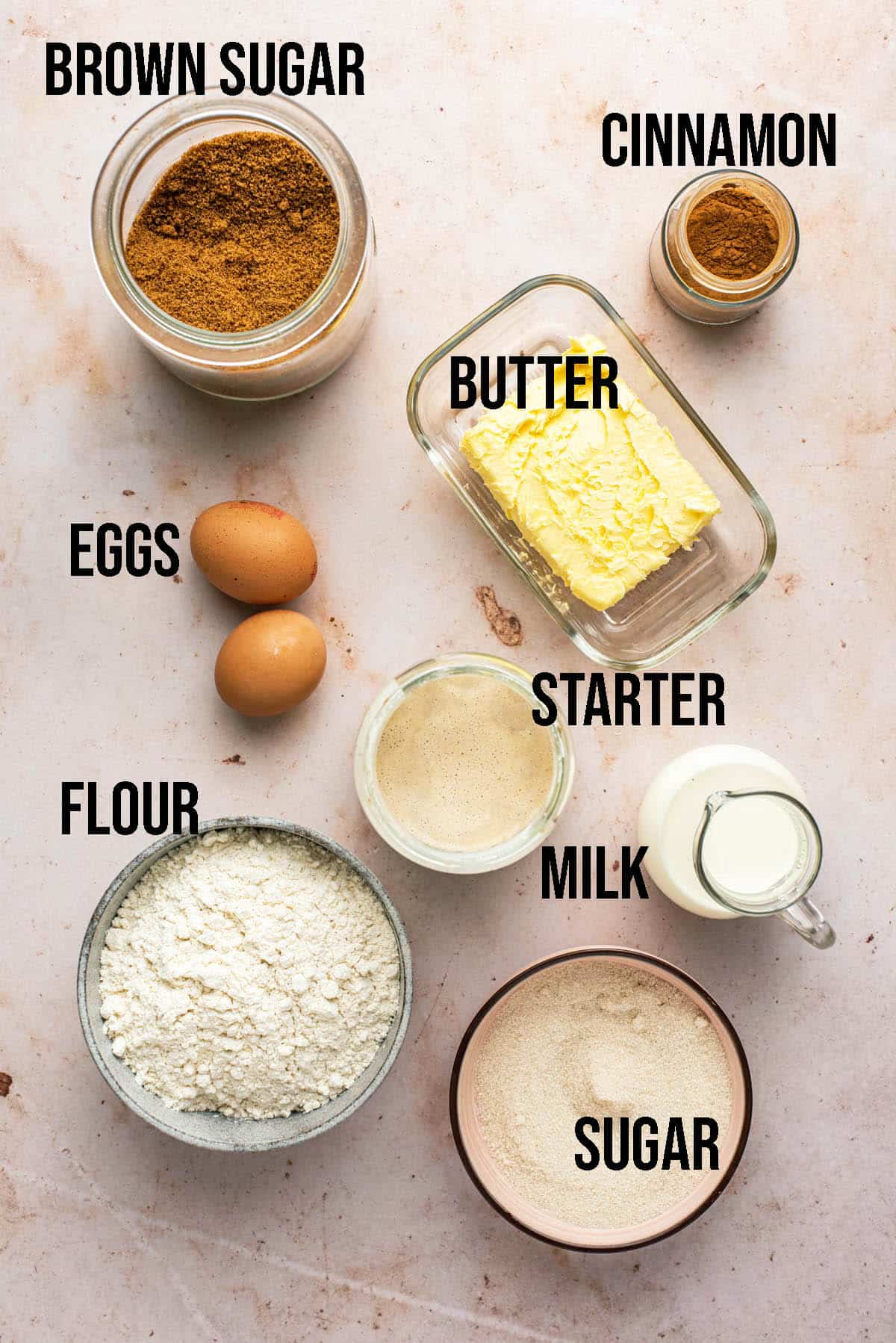
Ingredient Notes and Substitutions
- Sugar: cane sugar and plain white sugar can be used interchangeably for the dough base. Dark and light brown sugar can be used interchangeably for the filling.
- Starter: the type of starter you use doesn't matter, as long as it contains gluten. White, whole wheat, rye, all good. If you're worried about the rolls looking speckled with whole grains, simply make a levain from your whole grain starter with white flour.
- Make it dairy-free: use a good vegan butter and a non-dairy milk.
Method
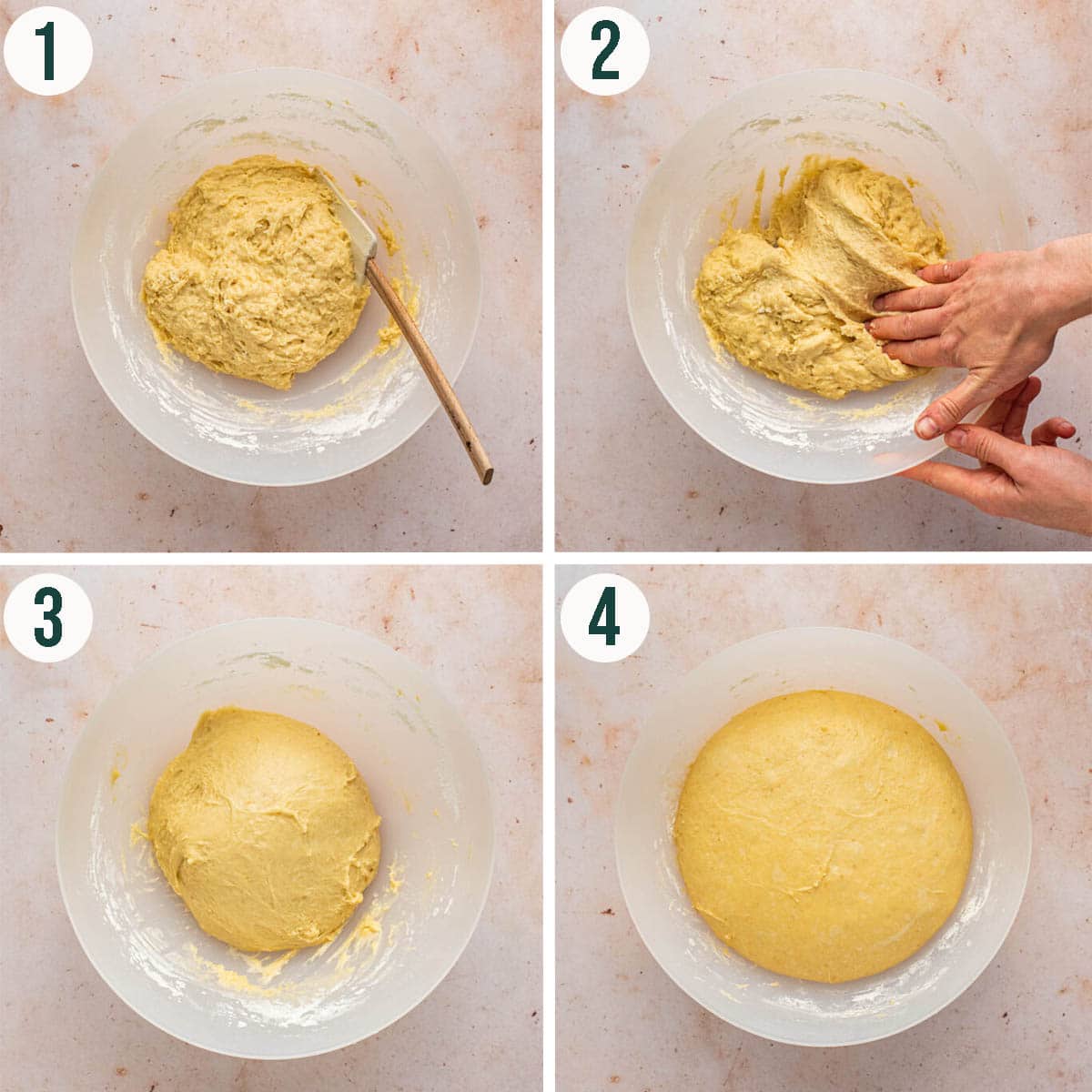
Step 1: heat the milk, then melt the butter into it. Mix in the starter and eggs, then mix in the dry ingredients to form a shaggy dough.
Step 2: do the stretches and folds.
Step 3: once you're finished, the dough should be smoother but still quite soft.
Step 4: let the dough rise until doubled in size, at room temperature, then optionally refrigerate.
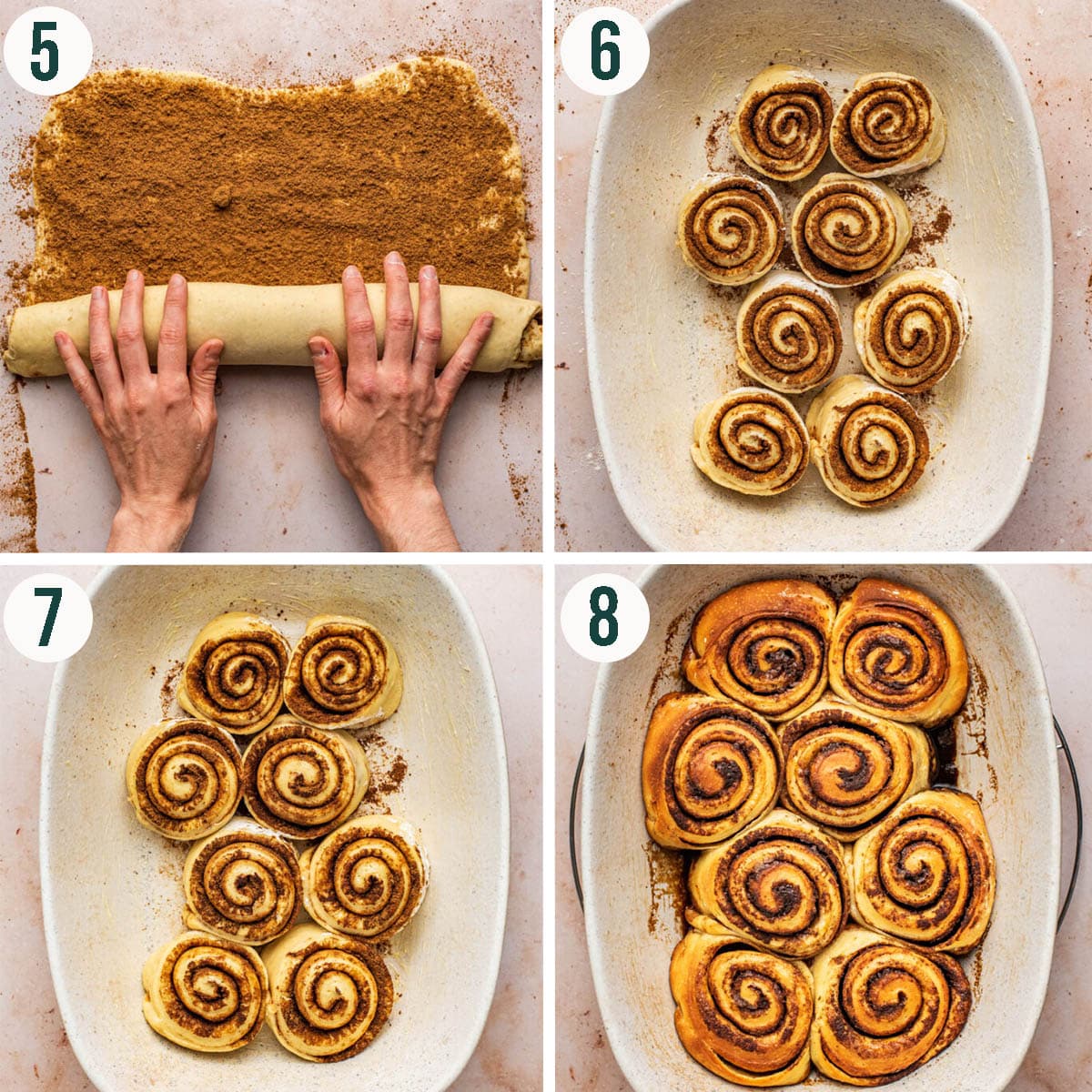
Step 5: roll the dough out into a large rectangle and add the filling. Roll up into a tight spiral.
Step 6: cut into rolls with a sharp knife or dental floss.
Step 6: let the rolls rise again at room temperature.
Step 8: bake until lightly golden and cool before serving.
Top Tips
- Use dental floss: use unflavoured or cinnamon dental floss to cut the rolls for the most precision. A very sharp knife is fine too.
- Use your hands: we don't recommend using a stand mixer for this recipe, as it doesn't require kneading.
- Give it time: sourdough takes time, and enriched dough even longer. The dough needs to double in size for the first rise, and a warm place is best for that.
Recipe Notes
Most of the issues we see from readers with enriched sourdough recipes result from ingredients being cold when they're added. Like any enriched dough, and virtually any cake, all ingredients should be at room temperature. If they're cold, it will retard the sourdough, and it'll take ages to rise.
If you're not sure, please look at our post on how to stretch and fold sourdough. It's a good guide for this method of gluten activation and will help if you need some step-by-step photos.
The baking dish pictured slopes at the sides slightly, which causes the rolls to lose their shape a little bit. Straight sides won't cause the same problem.
We say to cut the log into 10 equal rolls, and only 8 are pictured. The two end rolls were baked separately as the dish was a touch too small.
Don't place the rolls in a very warm place for the second rise, because all the butter will melt out. Room temperature is perfectly fine.
How to Store and Freeze Cinnamon Rolls
Storage: leftover rolls will keep for up to 3 days at room temperature in a sealed container, without frosting. If frosted, refrigerate, but note that the rolls will soften.
Freezing: place unfrosted cinnamon rolls in an airtight container and freeze for up to 3 months. Microwave for a few seconds to soften once thawed.
Room Temperature vs Chilling
Some of you may express some concern with eggs and milk being present in the dough while it proves at room temperature. This isn't an issue, and it isn't any different from any other enriched dough rising at room temp or in a proving drawer. The dough takes too long to prove in the refrigerator.
You have two options for the dough after it's doubled in size: first, refrigerate the dough before shaping (there are benefits!) or second, shape it immediately and bake without any refrigeration.
Choosing the first option, to refrigerate the whole bowl of dough before shaping into rolls, has a couple of good qualities. Most importantly, it makes the dough easier to handle and will result in cleaner, neater sourdough cinnamon rolls. It also improves the overall flavour and ensures a fully risen dough.
The dough doesn't need to be chilled overnight, but that's often the easiest option for people - you can chill for a couple of hours, or up to 12 hours, or not at all. It is stickier and harder to shape at room temperature so keep that in mind.
FAQ
Can you add cinnamon to sourdough?
We don't add cinnamon right into the dough for this recipe because it slows down rise, and enriched dough takes long enough as it is. See more on this in our cinnamon raisin sourdough recipe.
Is it better to use bread flour for cinnamon rolls?
Nope. While bread flour does have a higher gluten content and will give more structure to sourdough, it can be too much for cinnamon rolls, which should have a nice soft crumb.
What does butter do in a rich dough?
Enriched dough means that eggs, milk, butter, and/or sugar have been added. Butter coats and shortens gluten strands, making a more tender, soft, and rich bread.
More Sweet Sourdough Recipes
If you make this Sourdough Cinnamon Roll recipe or any other sourdough recipes on the Baked Collective, please take a moment to rate the recipe and leave a comment below. It’s such a help to others who want to try the recipe. For more baking, follow along on Instagram, TikTok, and YouTube.
Sourdough Cinnamon Rolls
Equipment
- Small saucepan
- Whisk
- Wooden spoon or spatula
- Measuring cups and spoons or a digital kitchen scale
- Mixing bowl
- Tea towel
- Dental floss or sharp knife
- pastry brush
- Baking dish
- Rolling Pin
Ingredients
Dough
- 180 grams whole milk
- 60 grams butter
- 100 grams sugar
- 2 large eggs
- 100 grams active sourdough starter
- 460 grams white all-purpose flour
- 8 grams sea salt
Filling
- 110 grams softened butter
- 100 grams brown sugar
- 1 tablespoon cinnamon
Instructions
Make the Dough
- Heat the milk in a small saucepan until just simmering.
- Add the milk to a large mixing bowl, then add the butter and sugar. Whisk to combine, until the butter has melted.
- Check the temperature of the milk mixture. If it's just warm to the touch or cooler, then it's fine to continue. If it feels hot, wait for it to cool down.
- Once the milk mixture has cooled enough, whisk in the eggs. Add the starter and whisk to combine.
- Add the flour and salt and use a wooden spoon or spatula to mix until a soft, shaggy dough forms. Cover and set aside to rest for 20 minutes.
- Do three rounds of stretches and folds over the course of an hour, one round every 20 minutes. After this, the dough should be soft and relatively smooth.
- Place the dough smooth-side up back into the mixing bowl. Cover with a tea towel or plate, and set aside in a warm, draft-free place to rise until doubled in size. Depending on ambient temperature and the strength of your starter, this can take anywhere from 4-10 hours.
- Once the dough has risen, you have two options. One, refrigerate for at least 2 hours before continuing. Two, skip the chilling step and move right to step 10, rolling and shaping. We recommend chilling.
- Place the risen dough into the refrigerator, in the mixing bowl (don't deflate the dough) and cover well. Chill for 2-12 hours.
- After chilling, tip the dough out onto a lightly floured surface.
Shape and Fill
- Grease a large baking dish with butter.
- Pat the dough into a rough round. Roll it into a log, then turn it so that it's seam-side up, and the short edge is facing you. Roll it into a log again from this direction. See this post on shaping boules for a visual guide.
- Roll the dough out into a large rectangle, about 30x40cm (12x16 in.) in size.
- Brush the softened butter onto the rolled out dough - this is why chilling is so helpful - then top with the brown sugar and cinnamon in an even layer.
- Roll the dough into a log again, working from the short end, and making sure it's rolled very tightly.
- Cut the log into 10 equal pieces with unflavoured dental floss or a very sharp knife.
- Place the rolls into the prepared baking dish, leaving a small space between each to allow for expansion during proving.
- Cover the dish with a tea towel and set aside at room temperature to rise for another 1-2 hours, or until puffy but not doubled in size.
Baking and Storing
- Preheat the oven to 350°F (180°C).
- Place the baking dish onto the centre rack of your oven and bake for 20-25 minutes, or until golden in colour and the tops of the rolls feel firm to the touch.
- Remove the dish from the oven and cool for at least 15 minutes before serving. Leftover cinnamon rolls will keep for up to 3 days at room temperature and freeze well in a sealed container, but are best fresh.
- If topping with cream cheese frosting, do so immediately before serving. Frosted rolls will not store very well.




